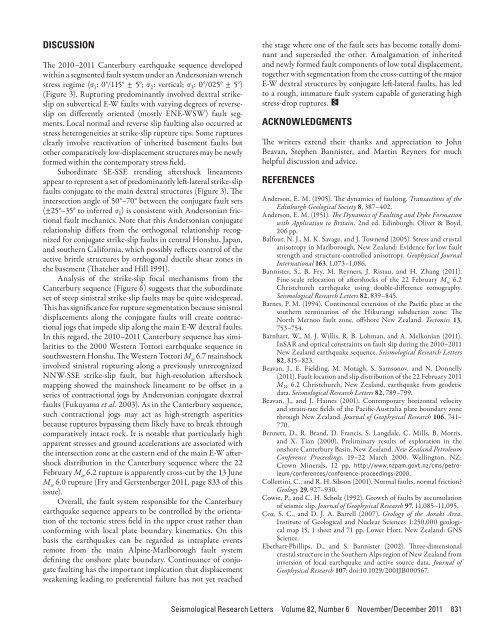Here - Stuff
Here - Stuff
Here - Stuff
Create successful ePaper yourself
Turn your PDF publications into a flip-book with our unique Google optimized e-Paper software.
DISCUSSIONThe 2010–2011 Canterbury earthquake sequence developedwithin a segmented fault system under an Andersonian wrenchstress regime (σ 1 : 0°/115° ± 5°; σ 2 : vertical; σ 3 : 0°/025° ± 5°)(Figure 3). Rupturing predominantly involved dextral strikeslipon subvertical E-W faults with varying degrees of reverseslipon differently oriented (mostly ENE-WSW) fault segments.Local normal and reverse slip faulting also occurred atstress heterogeneities at strike-slip rupture tips. Some rupturesclearly involve reactivation of inherited basement faults butother comparatively low-displacement structures may be newlyformed within the contemporary stress field.Subordinate SE-SSE trending aftershock lineamentsappear to represent a set of predominantly left-lateral strike-slipfaults conjugate to the main dextral structures (Figure 3). Theintersection angle of 50°–70° between the conjugate fault sets(±25°–35° to inferred σ 1 ) is consistent with Andersonian frictionalfault mechanics. Note that this Andersonian conjugaterelationship differs from the orthogonal relationship recognizedfor conjugate strike-slip faults in central Honshu, Japan,and southern California, which possibly reflects control of theactive brittle structures by orthogonal ductile shear zones inthe basement (Thatcher and Hill 1991).Analysis of the strike-slip focal mechanisms from theCanterbury sequence (Figure 6) suggests that the subordinateset of steep sinistral strike-slip faults may be quite widespread.This has significance for rupture segmentation because sinistraldisplacements along the conjugate faults will create contractionaljogs that impede slip along the main E-W dextral faults.In this regard, the 2010–2011 Canterbury sequence has similaritiesto the 2000 Western Tottori earthquake sequence insouthwestern Honshu. The Western Tottori M w 6.7 mainshockinvolved sinistral rupturing along a previously unrecognizedNNW-SSE strike-slip fault, but high-resolution aftershockmapping showed the mainshock lineament to be offset in aseries of contractional jogs by Andersonian conjugate dextralfaults (Fukuyama et al. 2003). As in the Canterbury sequence,such contractional jogs may act as high-strength asperitiesbecause ruptures bypassing them likely have to break throughcomparatively intact rock. It is notable that particularly highapparent stresses and ground accelerations are associated withthe intersection zone at the eastern end of the main E-W aftershockdistribution in the Canterbury sequence where the 22February M w 6.2 rupture is apparently cross-cut by the 13 JuneM w 6.0 rupture (Fry and Gerstenberger 2011, page 833 of thisissue).Overall, the fault system responsible for the Canterburyearthquake sequence appears to be controlled by the orientationof the tectonic stress field in the upper crust rather thanconforming with local plate boundary kinematics. On thisbasis the earthquakes can be regarded as intraplate eventsremote from the main Alpine-Marlborough fault systemdefining the onshore plate boundary. Continuance of conjugatefaulting has the important implication that displacementweakening leading to preferential failure has not yet reachedthe stage where one of the fault sets has become totally dominantand superseded the other. Amalgamation of inheritedand newly formed fault components of low total displacement,together with segmentation from the cross-cutting of the majorE-W dextral structures by conjugate left-lateral faults, has ledto a rough, immature fault system capable of generating highstress-drop ruptures.ACKNOWLEDGMENTSThe writers extend their thanks and appreciation to JohnBeavan, Stephen Bannister, and Martin Reyners for muchhelpful discussion and advice.REFERENCESAnderson, E. M. (1905). The dynamics of faulting. Transactions of theEdinburgh Geological Society 8, 387–402.Anderson, E. M. (1951). The Dynamics of Faulting and Dyke Formationwith Application to Britain. 2nd ed. Edinburgh: Oliver & Boyd,206 pp.Balfour, N. J., M. K. Savage, and J. Townend (2005). Stress and crustalanisotropy in Marlborough, New Zealand: Evidence for low faultstrength and structure-controlled anisotropy. Geophysical JournalInternational 163, 1,073–1,086.Bannister, S., B. Fry, M. Reyners, J. Ristau, and H. Zhang (2011).Fine-scale relocation of aftershocks of the 22 February M w 6.2Christchurch earthquake using double-difference tomography.Seismological Research Letters 82, 839–845.Barnes, P. M. (1994). Continental extension of the Pacific plate at thesouthern termination of the Hikurangi subduction zone: TheNorth Mernoo fault zone, offshore New Zealand. Tectonics 13,753–754.Barnhart, W., M. J. Willis, R. B. Lohman, and A. Melkonian (2011).InSAR and optical constraints on fault slip during the 2010–2011New Zealand earthquake sequence. Seismological Research Letters82, 815–823.Beavan, J., E. Fielding, M. Motagh, S. Samsonov, and N. Donnelly(2011). Fault location and slip distribution of the 22 February 2011M W 6.2 Christchurch, New Zealand, earthquake from geodeticdata. Seismological Research Letters 82, 789–799.Beavan, J., and J. Haines (2001). Contemporary horizontal velocityand strain-rate fields of the Pacific-Australia plate boundary zonethrough New Zealand. Journal of Geophysical Research 106, 741–770.Bennett, D., R. Brand, D. Francis, S. Langdale, C. Mills, B. Morris,and X. Tian (2000). Preliminary results of exploration in theonshore Canterbury Basin, New Zealand. New Zealand PetroleumConference Proceedings, 19–22 March 2000. Wellington, NZ:Crown Minerals, 12 pp. http://www.nzpam.govt.nz/cms/petroleum/conferences/conference-proceedings-2000.Collettini, C., and R. H. Sibson (2001). Normal faults, normal friction?Geology 29, 927–930.Cowie, P., and C. H. Scholz (1992). Growth of faults by accumulationof seismic slip. Journal of Geophysical Research 97, 11,085–11,095.Cox, S. C., and D. J. A. Barrell (2007). Geology of the Aoraki Area.Institute of Geological and Nuclear Sciences 1:250,000 geologicalmap 15, 1 sheet and 71 pp. Lower Hutt, New Zealand: GNSScience.Eberhart-Phillips, D., and S. Bannister (2002). Three-dimensionalcrustal structure in the Southern Alps region of New Zealand frominversion of local earthquake and active source data. Journal ofGeophysical Research 107; doi:10.1029/2001JB000567.Seismological Research Letters Volume 82, Number 6 November/December 2011 831
















